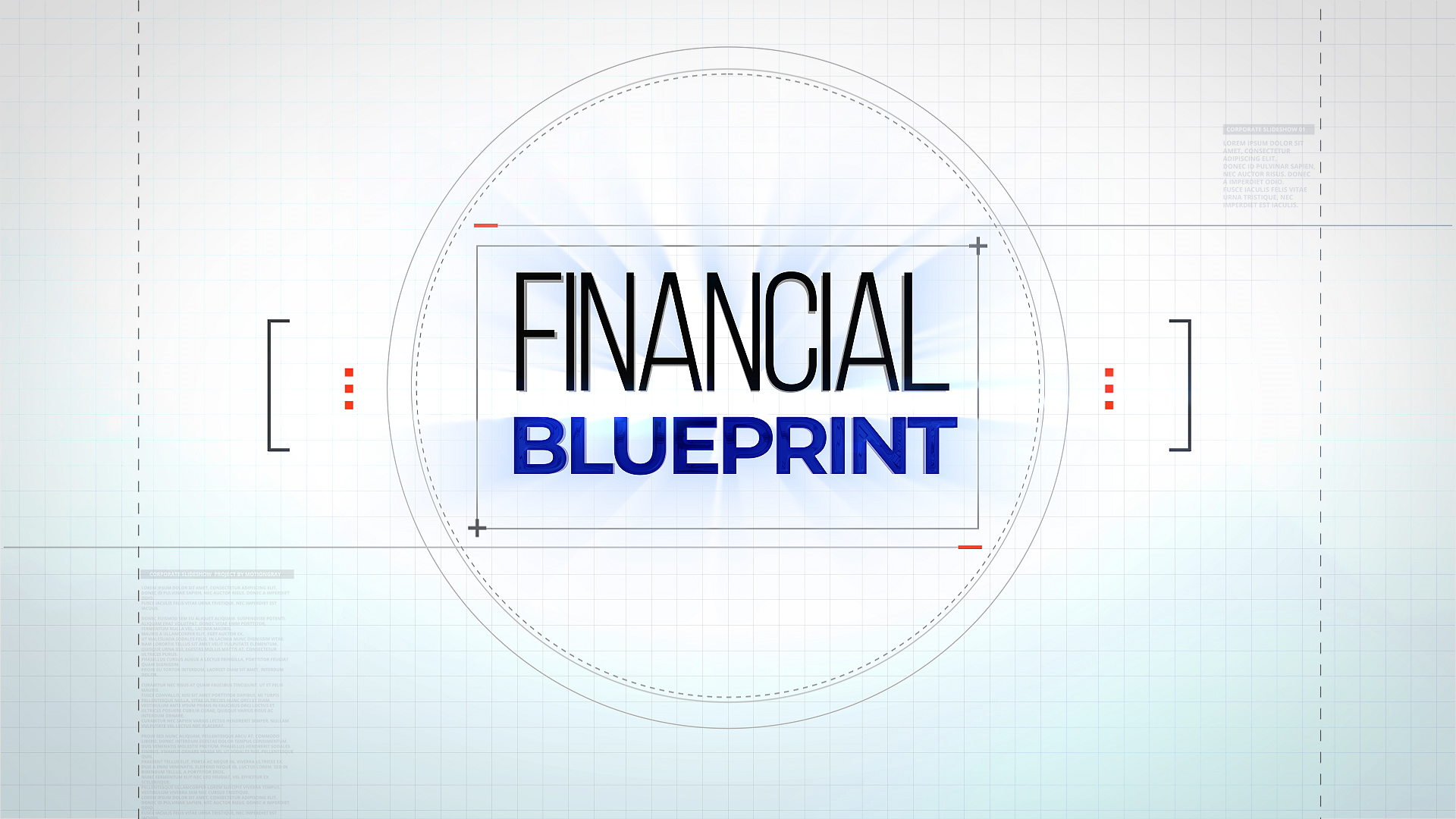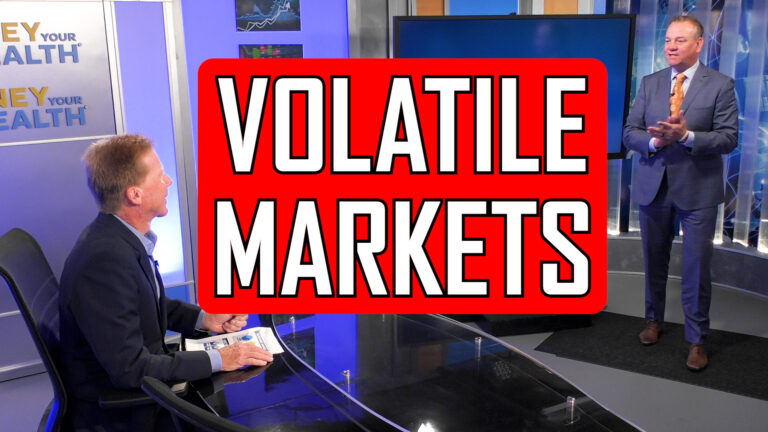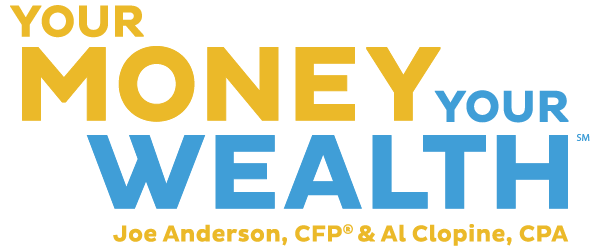61% of working Americans fear retirement more than death. How can you avoid this retirement panic? Let Joe Anderson, CFP® and Big Al Clopine, CPA, calm your nerves with seven practical plans for your income, spending, savings, and healthcare to put you on the path to an anxiety-free retirement.
Calculate your FREE Financial Blueprint
Important Points:
- 00:00 – Intro 02:04 – Retirement Income
- 03:00 – Retirement Spending
- 04:57 – Calculate your free Financial Blueprint
- 06:14 – True/false: Over 60% of Americans ages 50 plus are worried they won’t have enough money for retirement
- 07:26 – Retirement Savings
- 10:34 – Healthcare
- 11:10 – Calculate your free Financial Blueprint
- 12:31 – Almost 50% of retirees don’t use a formal withdrawal strategy, just taking out what they need as they go
- 12:53 – Prepare a strategy to draw down assets
- 14:40 – Prepare for sequence of returns risk
- 15:16 – Prepare for a phased retirement
- 15:42 – Imagine your ideal retirement
- 16:34 – Signs you’re ready to retire
- 17:13 – I know creating a retirement plan will ease my anxiety but where do I start?
- 17:54 – Calculate your free Financial Blueprint
Subscribe to Your Money, Your Wealth® on YouTube!
Transcript:
(NOTE: Transcriptions are an approximation and may not be entirely correct)
Joe: Are you ready to hit that panic button for retirement? Well stop. We got the remedy for you.
Welcome to the show, folks. Show called Your Money, Your Wealth®. Joe Anderson here, CERTIFIED FINANCIAL PLANNER®, president of Pure Financial Advisors. And of course I’m with the Big Man. He’s sitting right over there.
Al: Good morning again.
Joe: You got that panic button, Big Al?
Al: I’ve got it. I’m gotta push it. And then we’re gonna figure out how to solve it.
Joe: Man, a lot of people are panicking about retirement. Look at these stats folks. Alright? 64% are more worried about retirement than they are getting a divorce. How about death over half. 61% are more worried about their retirement than dying. Or how about getting fired or poor health? Retirement’s at the top of the list where people are panicking, but we got a plan for you. That’s today’s financial focus.
All right. What are the causes? Of the anxiety, this is just to name a few. No income plan. They don’t wanna have a strategy to create the income that will last their lifetime. Oh, number B, outliving their money. Number C, not enough saved. Right? You see the recurring themes here in healthcare cost. I don’t have enough money. I don’t have a strategy. Do I save enough or have I saved enough? And healthcare is gonna eat away my savings anyway. There’s remedies for all of this. Don’t panic. Let’s bring in Big Al.
Al: So we are panicking. We’re panicking about our income. We don’t seem to have enough income, or we’re spending too much, and as a result, we’re not saving enough. We’re panicking about these things. And then we think about healthcare as we get older. We tend to spend a little bit more for healthcare, so we’re concerned about that.
But as Joe just said, there are remedies and we’re gonna prepare and plan and talk about what those remedies are. So there’s no reason for people to panic.
Joe: No, let’s talk about what people are panicking and then what the plan is. Al, I got panic. You got plan? Okay. Panic. Alright, hit that panic button.
Retirement Spending
Al: We don’t have a clear income plan.
Let’s first figure out what sources of income we have, right? So we got sources of income in retirement. Of course we got Social Security. Maybe we have a pension plan. We have our own savings, right? We got 401(k), we got 403(b). Things of that sort that we can create income from. Maybe we have an annuity, maybe we have real estate, maybe we’ve got bond, or see the ladders that come to you at different times.
We gotta look at our income sources. And Joe, I think that’s step number one.
Joe: Yeah, it’s just taking inventory of what you have and then figuring out a, how much money do you want to derive from the overall portfolio? And then come up with a strategy. Do you have a 401(k) plan? Do you have pension, Social Security?
How is all of this gonna come together? There’s a formalized plan that you’ll have discipline to make sure that you get that income. Number two, panic. We’re fearing of outliving our savings. That’s a huge fear. We’re living a lot longer, big Al, and it’s like, do I have enough saved to make sure, right? I run outta money before I run outta breath.
Al: I think this is one of the biggest ones, Joe. So here’s your remedy, right? Let’s do a little stress test. Test run. Let’s, what does that mean? So basically that means figure out what your income sources are in retirement. Your 401(k) and then the like, maybe you take 4% outta that, plus your income sources and then try to live on that for a while.
If you’re working right. See how it goes. Or if you’re already retired, have that amount come into your checking account from savings, Social Security, whatever each and every month. See if you can get by on that, and that’s a great way to figure out how this is gonna work.
Joe: Yeah, that’s a really good point.
So a trial run. Hypothetically, you have a hundred thousand dollars saved. 4% of the a hundred thousand is $4,000, and let’s say you have a combined sale or combined Social Security of 40 grand. Can you live off of $44,000 plus a little bit of cost of living for the rest of your life? If you can’t, you’re probably not.
Right If you can, alright, now you can hit go for your overall retirement. Another panic. People have high credit card debt, or even debt in general going into overall retirement. Most people like to mitigate that, but sometimes it’s unavoidable.
Al: What you wanna do is come up with a plan for paying the debt off.
Now, if it’s credit card debt, then maybe you figure out how to pay it. Maybe you pay your highest cards first. Maybe you pay your lowest balance first to get started, Joe, it could be card debt, it could be student loans for kids. Right. All kinds of
Joe: things. Yeah. I mean, it’s a big deal. 71% of retirees have an average balance of $20,000 in debt that is not even related to their mortgage payment.
So this is credit cards.
Al: That’s your, yeah. And we know Joe, credit card debt can be very high interest rate.
Joe: Alright. If you’re panicking, what you gotta do is you gotta go to your moneyyourwealth.com. Click on our special offer this week. It’s our Financial Blueprint. If you don’t have a blueprint for your overall retirement, this is your opportunity. It’s free of charge. You can download it right there, answer some questions, and you can see where you stand. Are you panicking about retirement? This will ease that stress level substantially. YourMoneyYourWealth.com, click on that special offer. It’s our gift to you when we get back. If you’re a little bit short on savings, that’s what we’re gonna break things down. Savings, savings, and more savings. Don’t go anywhere.
Retirement Savings
Don’t panic folks. We’re back, show’s called Your Money, Your Wealth®, Joe Anderson and Big Al, breaking things down. A lot of you are panicking about retirement. Go to yourmoneyyourwealth.com. Click on that special offer this week. It’s our Financial Blueprint. If you haven’t done the Financial Blueprint, I encourage you to do so. It’ll take you five minutes. Answer some questions. It will tell you are you on track? Not on track. You might need to do a little bit of work here.
At least you know, once you know you could put that in action your money or wealth.com. Click on that special offer. It’s our Financial Blueprint. Alright, let’s see how you did on that true false question.
Al: Over 60% of Americans ages 50 plus are worried they won’t have enough money for retirement. True or false? That turns out to be true.
Joe: So 60% of Americans are worried that they’ve saved enough. I would say it’s probably almost 95%. some people might be a little bit overconfident here, but let’s break things down Al. If I’m looking at retirement need versus savings, so this was done by Northwestern Mutual and so they surveyed individuals 30 to 39 year olds.
They think they need $1.77 million to retire. What do they have on average? 60K, but they’re 30 to 39. They got a long way to go. How about 40 year olds? They believe they need 1.3 million. What do they have? $92,000. Lot of work here. 50 to 60. They need that 1.7. They got 116. So here’s what perception is, and here’s reality.
So there’s a huge gap in regards to the retirement crisis we’re living in.
Al: there is, and we see this all the time and I get you’re in your twenties or thirties and you’ve got a long way to go, even forties you got, but you’re in your fifties or even late fifties or even sixties. A lot of people are so far behind the eight ball.
Joe: they’re panicking. We haven’t saved enough. This should encourage you to say, all right, where should I start? Where should I be thinking about? There’s a lot of different avenues where people can save, and it’s even getting better year by year.
Al: it is, and especially right now, Joe, because when you’re over 50, you have a catch up plan, right?
Meaning you can add more to your 401(k), 401(k). 2025, you can put in 23,500, but Joe, if you’re over 50, you can put in even more.
Joe: Yeah, $7,500 catchup on top of the standard defined contribution. So if you have a four one K, 403(b), here’s your catchup. Once you hit 60, that’s 60 to 63. We call it the Super Catchup, 11,250, and then $7,500 back to 64 and 70.
These are your standard defined contributions. Now, of course, your employer could be matching as well, but then there’s after tax contributions that of a lot of you could take advantage of where you could put even more than these dollars in. That would be an after tax contribution. So look at your plan doc to see how much that you can actually put in the plan.
Some of you’d be shocked that you could take advantage of really cool things.
Al: and it’s really important because I think a lot of people, their twenties and thirties, they buy their first home. They start having kids, right? Their forties, maybe college, and then by 50 fifties it’s like, wow, I’m pretty far behind.
That’s why we have the ketchup. Please take advantage of it.
Joe: Alright, panic. Unsure. When did it take Social Security? Is it gonna even be there? Should I claim it at 62? Should I claim it at 70 or somewhere in between? How does it all work? Is it gonna be tax, not taxed? Very confusing.
Al: So you gotta have a plan, Joe, and the plan is consider what’s gonna work best for you.
Consider your life expectancy, are you married? Consider the fact that the highest benefit between you and your spouse will continue. When the first one of you passes away and consider about both your life expectancies and do you need the cash right now? If you can. If you can wait, Joe, you get a much bigger benefit later.
Joe: Yeah, and I think it’s really dependent on what your game plan is. I think a lot of advisors say, we’ll, push this thing out as much as you can, because if you take it at 62, in this hypothetical example, just assume your benefit is a thousand dollars a month just to make the math easy. So if you take it at 62, your benefit is $700, a 30% haircut.
Or if you take it at 70, it’s $1,200. But if I take it here, that’s $700 a month that I don’t necessarily have to take from my portfolio if I wait until 67, I have to draw that portfolio down a little bit until I reach my full retirement age or age 70. Some people think of a break even point.
This is all strategy in regards to your overall plan. Like Al said, are you married? Are you single? What are the benefits of you and your spouse? Lot of different combinations that you wanna make sure that you take advantage of.
Al: Yeah, Joe, I think it’s interesting when you look at the, you can first take it at 62, right?
In this example, $700 in age 70, 1240. That’s almost an 80% increase to wait till age 70. So it’s a big deal. Alright,
Joe: healthcare, there’s a panic, right? This is a big fear for a lot of people.
Al: Do I have enough to cover my medical expenses, and you gotta have a plan because healthcare is very important. Now, at 65, you do qualify for Medicare, but Medicare doesn’t cover everything.
You might wanna have a Medigap or supplemental policy to help cover additional me. You may. You may wanna have a long-term care policy to cover that skilled nursing care that you might need. Maybe you got a HSA health savings account. If you do, you have that ability. Make sure you fund that as much as you can.
Joe: Hey, if you need some more help with this, break it down with our Financial Blueprint. You could do it right there in the comfort of your own home. Answer some questions and then a report will pop out and it will tell you, all right, red, yellow, green. Are you on track? Not on track. Some work to do, at least, you know.
Then you can put some pressure on it. And get to your goals, your money or wealth.com. Click on that special offer. It’s our Financial Blueprint. All right, we gotta take a break, but when we get back, we’re gonna talk about withdrawal strategies. I think most people, Hey, I know how to save a couple of bucks, but how do I take it out?
How do I create the income that I need? How do I reduce my overall tax bill? How do I make sure that I don’t outlive my money? That’s what we’re gonna talk about when we get back. The show is called Your Money, Your Wealth®.
Prepare for Retirement Withdrawals
Hey, welcome back. A lot of you are panicked about retirement. Hopefully we are calming those nerves. If you need more help, go to yourmoneyyourwealth.com. Click on that special offer this week. It’s our Financial Blueprint. Super easy to do. It will give you really good information, a starting point on what things that you should be thinking about in your overall financial life.
Cover multiple different areas, so take advantage of it. Free of charge. You can download it. It’s a report right there in the comfort of your own home. Your money wealth.com. Click on that special offer. It’s our Financial Blueprint. Let’s see how you did on that. True false question folks.
Al: Almost 50% of retirees don’t use a formal withdrawal strategy, just taking out what they need as they go.
True or false? that is true. It’s not only how much you can take out, but should it come outta your retirement account or your Roth account or your non-retirement account. Where should we be taking this money and taxes play such a big part.
Joe: Yeah, huge part. So when you think about your overall situation, this is a really good chart to think about.
You got tax free dollars, right? This is your Roth IRAs. How many of you have Roth IRAs? So you kind of put your dollar figure in here. Most of you probably have a lot of your wealth or liquid wealth in your tax-deferred. Tax-deferred is like a pre-tax dollar going in gross tax deferred. But when it comes out of this account, just know that you have to pay tax at ordinary income rates.
So how much that you pull out is gonna determine the rate that you pay in tax. But this is the highest rate taxable investment. So this is anything outside of a retirement account. This could be a stock bond, mutual fund real estate. So this is a capital asset. So if you sell these assets at a gain, of course you have to pay tax, but it’s at a lower rate than ordinary income, but higher, of course than tax free.
So the point is that most people have all of their dollars here, or most of their dollars here. They could have a pension, they could have Social Security, they might have purchased an annuity or something like that. Most income that we see from strategies of all of you are taxed at the highest rates.
You don’t necessarily have any diversification. From a tax perspective, if you have dollars here, ideally it would be great if your total liquid net worth was there because every dollar that you pull out, you never pay tax ever again, ideal. But if it’s here, it’s ordinary income. But if I have a little bit in each of these different accounts, or a lot in all of these accounts.
You could have diversity, you could pull from these accounts to control your tax brackets on an ongoing basis. If I could control my taxes, that’s gonna spread those dollars out. Longer than everything.
Al: Taxed at the highest rates. Yeah. Something else we gotta consider is sequence of returns risk. ’cause the market, we know it goes up, it goes down, what if we retire or if we’re, if we are retired and the market goes down, we need to have.
Safe money. We don’t wanna pull money out of the market outta the stock accounts that we have while the market’s down. We want to have some safe money to guard against those periods of time where the market’s falling. So maybe you have a couple years in very safe, accounts, like a savings account, CD, something like that. Some people maybe wanna be a little bit more conservative. Maybe they have five years or even more in bonds so they can pull money out of there when the market’s down.
Joe: 70% of us do not have like this stage or phase retirement with our employers. Usually it’s, you retire. Okay, here’s your last check.
Here’s your PTO. Thank you very much. But some employers will let you kind of phase in, get used to that overall retirement, cut your hours and retire when you’re ready. 33% of employers, so that means what? About 70% do not true, but a third do. Alright, how about this? Imagine your ideal retirement. Al, are you, imagining it right now?
I can think about it right here as I’m sitting. Alright. You gotta imagine your ideal retirement. This is really important. Take stock of your health. Number two, just get your finances in order. Use our Financial Blueprint. Use a napkin. I don’t care. Just start putting together what you have. And where you need to go get your estate planning documents in order and then build that support group.
Because what we find is that people that transition into retirement. Right. Most of your social circle was through your employer, the people that you work with. Now you’re retired. You just wanna make sure that you have that support group and that you have that social circle that you can still, lean on.
Signs You’re Ready to Retire
Al: Also, you gotta. Recognize the signs you’re ready to retire. Financially prepared that maybe that’s number one. When you’re able to retire, maybe you should really think about it. Maybe your work isn’t that fulfilling anymore, so maybe that’s a sign you need to retire. Or you got new dreams you get, you wanna volunteer, you wanna spend more time with the grandkids, you wanna travel more.
Joe: So let’s check the boxes. Al, are you financially prepared?
Al: I think yeah.
Joe: We’ll check that one. I got that work isn’t fulfilling. Oh, we’ll that’s a double check for you, big Al. You got new dreams on the horizon.
Al: Absolutely, I do.
Joe: Okay. But health, no, your health is perfect. I’m good. Your health is perfect.
Al: I’m good there.
Joe: Alright, let’s switch gears folks. We got a couple questions that came in. Let’s answer them.
Al: I know creating a retirement plan will ease my anxiety. But where do I start? This is from Jill in San Diego. a great place to start is look at your income sources like Social Security. Pension, maybe you got some real estate income. Compare that to your expenses right now. Usually you have a shortfall. You have more expenses than income, and that’s okay. That’s why you save money, right? Take that shortfall, multiply it by 25, and then compare that to how much you have saved. Do you have enough? Do you need to have a little bit more saved? That’s a good starting point.
Joe: Anyone get all that? Here’s a better way, right? No, it’s a layup Al, just go to YourMoneyYourWealth.com. Click on our Financial Blueprint. That’s a really good way to start. It’s absolutely free of charge. YourMoneyYourWealth.com. Click on that Financial Blueprint. You could do it in the comfort of your own home. It’s a few questions. It will tell you, you on track, in some action steps to take. Alright, so hopefully we ease that panic button today. for Big Al Clopine, I’m Joe Anderson. We will see you next time folks.
IMPORTANT DISCLOSURES:
• Investment Advisory and Financial Planning Services are offered through Pure Financial Advisors, LLC. A Registered Investment Advisor.
• Pure Financial Advisors, LLC. does not offer tax or legal advice. Consult with a tax advisor or attorney regarding specific situations.
• Opinions expressed are subject to change without notice and are not intended as investment advice or to predict future performance.
• Investing involves risk including the potential loss of principal. No investment strategy can guarantee a profit or protect against loss in periods of declining values.
• All information is believed to be from reliable sources; however, we make no representation as to its completeness or accuracy.
• Intended for educational purposes only and are not intended as individualized advice or a guarantee that you will achieve a desired result. Before implementing any strategies discussed you should consult your tax and financial advisors.
CFP® – The CERTIFIED FINANCIAL PLANNER® certification is by the CFP Board of Standards, Inc. To attain the right to use the CFP® mark, an individual must satisfactorily fulfill education, experience and ethics requirements as well as pass a comprehensive exam. 30 hours of continuing education is required every 2 years to maintain the certification.
AIF® – Accredited Investment Fiduciary designation is administered by the Center for Fiduciary Studies fi360. To receive the AIF Designation, an individual must meet prerequisite criteria, complete a training program, and pass a comprehensive examination. Six hours of continuing education is required annually to maintain the designation.
CPA – Certified Public Accountant is a license set by the American Institute of Certified Public Accountants and administered by the National Association of State Boards of Accountancy. Eligibility to sit for the Uniform CPA Exam is determined by individual State Boards of Accountancy. Typically, the requirement is a U.S. bachelor’s degree which includes a minimum number of qualifying credit hours in accounting and business administration with an additional one-year study. All CPA candidates must pass the Uniform CPA Examination to qualify for a CPA certificate and license (i.e., permit to practice) to practice public accounting. CPAs are required to take continuing education courses to renew their license, and most states require CPAs to complete an ethics course during every renewal period.










